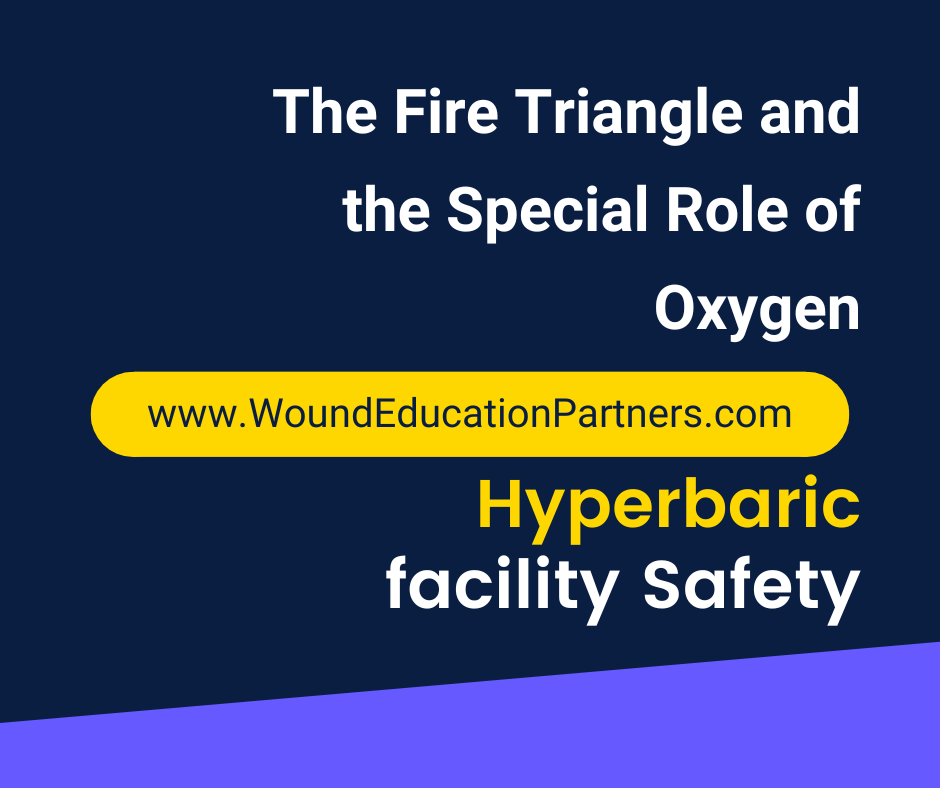Rx Pad
The Fire Triangle and the Special Role of Oxygen
In general, fire prevention is described in terms of the Fire Triangle model. For a fire to occur, a fuel, an oxidizer, and an ignition source must be present. Fire prevention in a hyperbaric chamber must account for an increase in the oxygen component of the atmosphere in terms of both oxygen fraction and partial pressure. The resultant increase in oxygen renders what might be inactive fuels and ignition sources in a “normal” air environment active, which increases the risk of a fire.
The oxidizer in a hyperbaric environment is generally “air” which has a remarkably constant oxygen concentration of 21% but can, by standard, vary from between 19.5% and 23.5%. In certain applications and treatments, the oxygen concentration can increase and can be as high as 100%. In addition to the increased oxygen concentration, the oxygen partial pressure will increase as a direct function of the total pressure such that at two atmospheres the partial oxygen pressure or PO2 is twice that at one atmo- sphere. At a given pressure, when the oxygen fraction or percentage of an atmosphere is changed, the partial pressure is changed as well.
Two terms are commonly used to refer to the environment within a hyperbaric chamber as it relates to the definition of the amount of oxygen. First, in an oxygen-enriched atmosphere, the concentration of oxygen exceeds 21% by volume or its partial pressure of oxygen exceeds 21.3 kPa (160 torr).1 Second, an atmosphere of increased burning rate is any atmosphere containing a percentage of oxygen, or oxygen and nitrous oxide, greater that the quotient of 23.45 divided by the square root of the total pressure in atmospheres.2 While both of these definitions have wide subscription, are the basis of standards, and are conservative when applied to the normal range of hyperbaric environments, both definitions may not fully define the hazards associated with the hyperbaric environment. Certain oxygen-enriched atmospheres can exhibit combustion-supporting properties similar to ambient air, while others are incapable of supporting the combustion of normally flammable materials. For example, a 4% oxygen mixture in nitrogen or helium with a total pressure of 12 atm (1.2 MPa) will not support combustion of paper, even though the partial pressure of oxygen is 0.48 atm (48.6 kPa).3 The second definition is based on results for filter paper burning at 1 atm (101.3 kPa) and does not fully address the variety of materials whose ignition and burn rate may have a greater or lesser dependence on oxygen concentration and pressure effects.2
The fuel in a hyperbaric environment can be any unoxidized material within the environment, including metals, plastics, fabrics, salves, dressings, anesthetic agents, wire insulation, and composite materials. Whether a material will sustain combustion is a function of the specified environmental conditions and the material’s configuration.
Ignition sources include any energy source capable of providing sufficient energy to overcome the reaction activation energy and initiate the combustion reaction. In a hyperbaric chamber, common ignition sources include electrical arc, friction, thermal ignition from hot surfaces, and possible static discharge. In piping systems, particle impact and adiabatic compression are also considerations. In the past, fires were caused by open flame from cigarette smoking, and in the future, fires may be caused by “high-tech” instrumentation. Oxygen fires in general are caused by ignition of a small amount of highly flammable material (often a contaminant), which then progresses in a kindling chain fashion to ignite less flammable bulk material such as polymers, which then can ignite even less flammable metallic system components.
Excerpted with permission from the publisher. Source Reference Hyperbaric Facility Safety: A Practical Guide, Second Edition
Learn More With Team Training in Hyperbaric Facility Safety with our 16-hour CEU Course! Find more details here.
When you subscribe to the blog, we will send you an e-mail when there are new updates on the site so you wouldn't miss them.



Comments